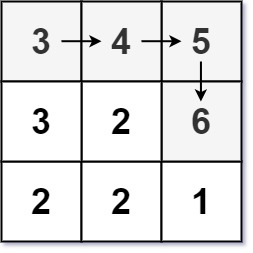1
2
3
4
5
6
7
8
9
10
11
12
13
14
15
16
17
18
19
20
21
22
23
24
25
26
27
28
29
30
31
32
33
34
35
36
37
38
39
40
41
42
43
44
45
46
| // @lc code=start
impl Solution {
/// ## 解题思路
/// - dfs
pub fn longest_increasing_path(matrix: Vec<Vec<i32>>) -> i32 {
//
fn dfs(matrix: &[Vec<i32>], step: (usize, usize), stat: &mut Vec<Vec<Option<i32>>>) -> i32 {
// 如果该点遍历过, 则直接返回;
if let Some(c) = stat[step.0][step.1] {
return c;
}
let mut ret = 1;
// 从该点开始, 前后左右四个方向递归遍历
for d in [0, -1, 0, 1, 0].windows(2) {
let (ni, nj) = ((step.0 as i32) + d[0], (step.1 as i32) + d[1]);
let (ni, nj) = (ni as usize, nj as usize);
if (0..matrix.len()).contains(&ni) && (0..matrix[0].len()).contains(&nj) {
// 递增方向
if matrix[ni][nj] > matrix[step.0][step.1] {
// 当前坐标路径最大递增长度 为四个方向中最长的那个+1
ret = ret.max(dfs(matrix, (ni, nj), stat) + 1);
}
}
}
// 记录该坐标最长递增路径
stat[step.0][step.1] = Some(ret);
ret
}
let mut res = 0;
let mut stat = vec![vec![None; matrix[0].len()]; matrix.len()];
for i in 0..matrix.len() {
for j in 0..matrix[0].len() {
// 所有点开始的最长递增路径 中 最大的
res = res.max(dfs(&matrix, (i, j), &mut stat));
}
}
res
}
}
// @lc code=end
struct Solution;
|

